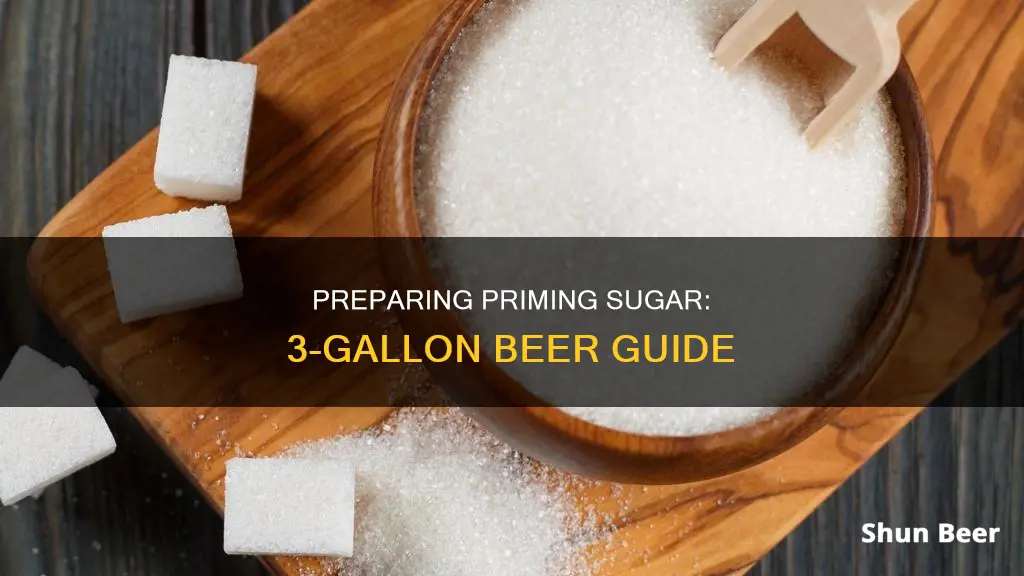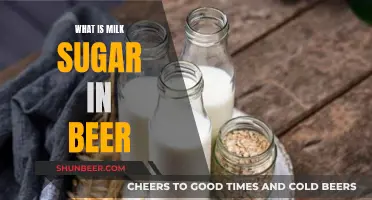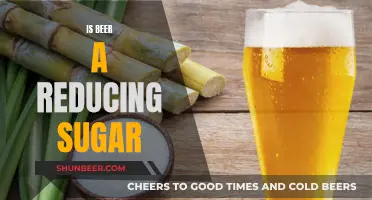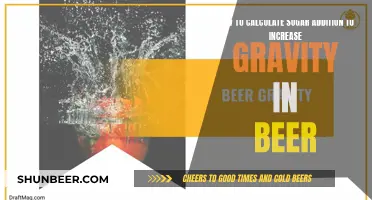
Preparing priming sugar for 3 gallons of beer is an important step in the homebrewing process. Priming sugar is added to beer to create carbonation, giving it that refreshing fizz. While it is possible to drink beer without carbonation, adding priming sugar enhances the flavours and aromas of the brew. The priming sugar provides food for the yeast, which then creates carbon dioxide, adding bubbles to the beer.
There are several types of priming sugar that can be used, each with its own advantages. Corn sugar (dextrose) is a popular choice as it is neutral and does not alter the flavour of the beer. Table sugar (sucrose) is another simple sugar option that is cost-effective and easily accessible. However, it may put more stress on the yeast and produce inconsistent results. Dry malt extract (DME) is a unique option as it adds flavour and body to the beer, creating finer bubbles.
Calculating the correct amount of priming sugar to use is crucial to ensure the desired level of carbonation. Online priming sugar calculators can assist in determining the required amount based on the fermentation temperature, CO2 volume, and beer style. It is recommended to add priming sugar by weight rather than volume for more accurate and consistent results.
Preparing a priming solution involves mixing the calculated amount of priming sugar with water and boiling it to sanitise and dissolve the sugar. This solution is then combined with the beer, taking care not to introduce oxygen or stir up sediment. The beer is then bottled and left to ferment, resulting in a carbonated brew.
What You'll Learn

The priming sugar calculator
Bottle brewers rely on a priming solution, which is added to the brew during bottling, to carbonate their beer. This solution provides food for the yeast, which creates carbon dioxide (CO2) and adds the desired effervescence to the beer as it ages. The priming sugar calculator helps you determine the precise amount of sugar needed to achieve the perfect level of carbonation for your beer.
Types of Priming Sugar
There are several types of sugar that can be used to create a priming solution, each requiring a slightly different calculation for maximum efficacy:
- Corn Sugar (Dextrose)
- Table Sugar (Sucrose)
- Dry Malt Extract (DME)
- Honey
Using the Priming Sugar Calculator
To use the priming sugar calculator, you will need to input certain information, such as the type of priming sugar you are using and the volume of your brew. The calculator will then provide you with the amount of sugar needed to achieve your desired carbonation level. This eliminates the guesswork and reduces the risk of under or over-priming your beer.
Benefits of Using a Priming Sugar Calculator
Using a priming sugar calculator offers several advantages:
- Accuracy: The calculator provides precise measurements, ensuring your beer has just the right amount of carbonation.
- Convenience: There is no need to spend time running complex calculations manually.
- Consistency: By following the calculator's measurements, you can achieve consistent carbonation levels across your brew.
- Safety: Over-priming can lead to bottle bombs, while under-priming may result in flat beer. The calculator helps you avoid these issues.
Michelob Ultra Beer: Sugar Content and Health
You may want to see also

Preparing the bottles
Before you begin preparing your bottles, make sure you have the right amount. A traditional, five-gallon batch requires two cases (48) 12-ounce bottles. If you're preparing three gallons, you will need slightly fewer bottles. Clean and sanitise each bottle with a no-rinse brewing sanitizer like Star-San. If you're using old bottles, inspect them for mould.
You will also need to sanitise the caps. If you're using Grolsch-style bottles, you can sanitise the rubber seals.
Now, you need to prepare your priming sugar. To make sure the sugar dissolves evenly, boil two cups of water and dissolve your sugar in it. Boiling ensures sanitation and lets you use less water, as more sugar can be dissolved in hot water than in cold. Pour the mixture into your brew and stir it in. Be careful not to stir any sediment at the bottom of the bucket back into the beer.
When combining your beer and priming sugar, avoid splashing, as this introduces oxygen to the brew, which can negatively affect the flavour. You don't need to stir—the swirling motion of the beer as it's put into the bottling bucket will be enough to mix the priming solution and prevent aeration.
If you don't have a bottling bucket, pour your priming solution into your fermenter and stir it gently. Let any sediment settle for 15 to 30 minutes before you fill your bottles.
Lite Beer and Sugar: What's the Truth?
You may want to see also

Sanitising bottle caps
Sanitising your bottle caps is an important step in the homebrewing process. Here are some detailed instructions on how to do it:
Firstly, it is important to note that if you are using oxygen-absorbing caps, you should not get them wet as moisture will render the oxygen-absorbing liner useless. Instead, you can sanitise them with an acid-based sanitiser like Star San. If you are using regular bottle caps, you can sanitise them in a few different ways. One way is to boil them in water for a couple of minutes. This will help soften the rubber and create a better seal. Make sure not to boil them for too long, as this can dissolve the glue that holds the seal to the metal cap. Another way to sanitise bottle caps is to soak them in a sanitising solution such as Iodaphor or a no-rinse sanitiser like Star San. Simply place the caps in a bowl or bucket and cover them with the sanitising solution. You can then cap your bottles straight out of the bowl, shaking off any excess solution. If you have leftover caps, be sure to dry them thoroughly before storing to prevent rusting. Alternatively, you can spray the caps with a sanitising solution and coat the inside, then cap your bottles.
It is worth noting that some homebrewers choose not to sanitise their bottle caps at all, especially if they are using oxygen-absorbing caps or if the caps are sealed in a bag when purchased. However, sanitising the caps can help reduce the risk of infection and ensure the quality of your brew. Ultimately, the decision to sanitise or not is up to the individual brewer.
Beer Metabolism: Sugar Conversion Mystery Explained
You may want to see also

Boiling water and dissolving sugar
To prepare priming sugar for 3 gallons of beer, you'll need to create a priming solution by boiling water and dissolving sugar. Here's a step-by-step guide:
Step 1: Gather Ingredients and Equipment
You will need:
- A saucepan
- Bottling bucket
- Priming sugar (corn sugar, table sugar, or dry malt extract)
- Water
- Sanitizer
- Bottling equipment (bottles, caps, bottle filler)
Step 2: Prepare the Priming Solution
- Bring 16 ounces (.47 litres) of water to a boil in a clean saucepan.
- Add your chosen priming sugar to the boiling water. The amount of sugar will depend on the type of sugar and your desired carbonation level. Refer to priming sugar calculators and carbonation charts to determine the precise amount.
- Stir the mixture continuously until the sugar is completely dissolved.
- Cover the saucepan and set it aside while you prepare your bottling bucket.
Step 3: Mix the Priming Solution with Your Beer
- Ensure your bottling bucket and spigot are sanitized and securely closed.
- Carefully siphon your beer from the fermentation vessel into the bottling bucket, avoiding any sediment at the bottom.
- Add the prepared priming solution to the bottling bucket and gently mix it with the beer.
Step 4: Bottle Your Beer
- Move the bottling bucket into bottling position.
- Using a bottle filler, carefully fill your bottles with the beer, leaving about ¾ to 1 inch of headspace for carbonation.
- Cap the bottles securely and store them in a dry, room-temperature place.
Step 5: Age and Enjoy Your Beer
- Allow the beer to age for at least two weeks to give the yeast time to consume the priming sugar and create carbonation.
- After two weeks, chill a bottle and test your beer. If it needs more time, let the remaining bottles age for a few more days.
- Once your beer is carbonated to your liking, it's ready to be enjoyed!
Preparing priming sugar for beer involves precise calculations to achieve the desired carbonation levels. Always sanitise your equipment and work carefully to avoid contamination or altering the flavour of your brew.
Beer vs. Whiskey: Sugar Content Face-off
You may want to see also

Stirring the sugar into the beer
To stir your priming sugar into your beer, start by measuring your sugar. It's best to use scales for this, rather than cups or spoons, to ensure precision. Weigh out the amount of sugar you need for 3 gallons of beer and put it in a pan with twice that amount of water. Boil the priming solution for 5 minutes and then allow it to cool.
Pour the cooled priming solution into your bottling bucket. Carefully siphon your beer from your carboy into the bottling bucket, being sure to avoid pulling any of the trub (the sediment at the bottom of your brew) into the bucket with the brew, as it can alter the flavor and clarity. The action of siphoning the beer into the bottling bucket should help to thoroughly mix the beer and priming sugar solution.
If you don't use a bottling bucket, you can gently stir the priming solution into the beer in the fermenter. Take care not to splash or disturb the accumulated trub and yeast cake at the bottom of your fermented brew.
Once the beer and priming solution are mixed, you're ready to bottle your brew. Using a bottle filler, carefully transfer the mixture to your bottles, filling them all the way to the top. Removing the bottle filler wand will leave about 3/4 to 1 inch of headspace to allow for proper carbonation.
Priming Sugar Secrets: The Perfect Beer Mix
You may want to see also
Frequently asked questions
For 3 gallons of beer, you will need 3 oz of priming sugar.
The best type of priming sugar to use depends on your preference. Corn sugar, table sugar, and dry malt extract are three of the most popular types of priming sugar. Corn sugar is the best option if you are new to homebrewing.
To prepare the priming sugar solution, combine the priming sugar with water in a large pot. For 3 gallons of beer, use 3 oz of priming sugar and 2 cups of water. Bring the mixture to a medium-high heat and stir until the sugar is completely dissolved. Then, boil for 5 minutes, remove from the heat, cover, and let it cool completely.
After the priming sugar solution has cooled, transfer your beer from the fermenter into the pot with the priming solution and gently stir to combine. Now your beer is ready to be bottled!







